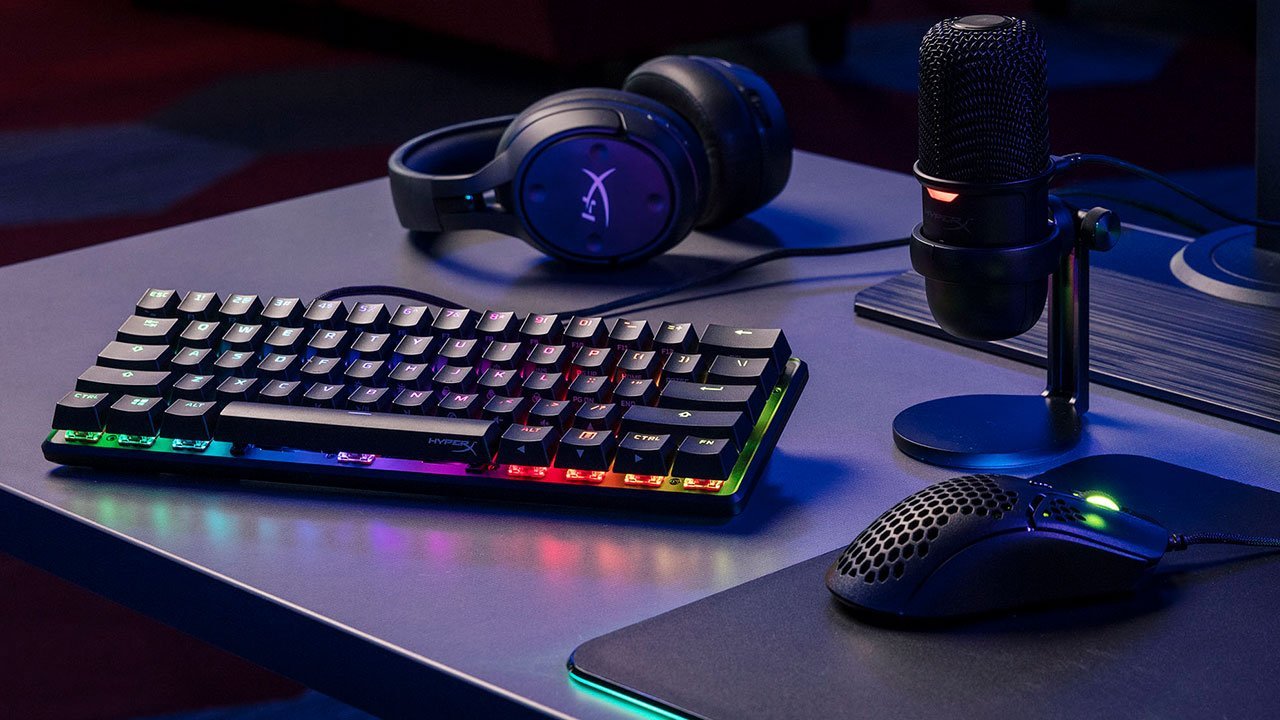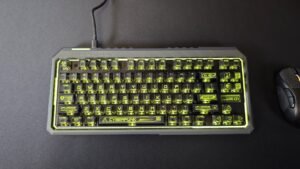As a lifelong console gamer whose last personal dalliance in building a gaming PC was when Quake II and Star Wars Jedi Knight: Dark Forces II ruled the PC gaming roost, I was hesitant at first to give the HyperX Alloy Origins 60 mini keyboard a shot. I was uncertain if a console cretin such as myself had any business messing around with a dedicated gaming keyboard, much less a mechanical one, but after making a quick visit to HyperX’s website and confirming that the product was also 100% compatible with PS5/PS4 and Xbox One/Xbox Series, I was definitely intrigued. After all, I’ve been timidly dipping my toe into content creation over the past year, and nothing quite gets an introvert like me out of their comfort zone than having to talk about a flashy peripheral that literally glows in the dark. Now having played about with the Alloy Origins 60 for about a week, I’m glad that I followed my instincts.
Visually, the Alloy Origins 60 bears a striking resemblance to the Razer Huntsman Mini keyboard which we reviewed almost a year ago, and the old adage about imitation being the greatest form of flattery definitely applies here. Much like the Huntsman Mini, the Alloy Origins 60 boasts an extremely compact form factor, measuring 60% smaller than its full-sized cousin. There’s practically no wasted space. HyperX’s official description proclaims that the reduced size “gives you more room for sweeping mouse movements,” but to a modest condo-dweller such as myself, such flourishes are a luxury; what I need is a keyboard that fits on my diminutive work desk and plays nice with all the other equipment occupying space there. Thankfully, the Alloy Origins 60 accomplishes that and more some, leaving enough room in fact that both the Alloy and my full-sized wireless keyboard can comfortably co-exist on my desktop and are easily interchangeable (more on that later). Also, while I don’t see myself ever “going pro” and travelling to e-Sports tournaments, the Alloy Origins 60 is also the perfect size for tossing into a computer backpack or carry-on should you need to get your KB+M gaming on during a trip.
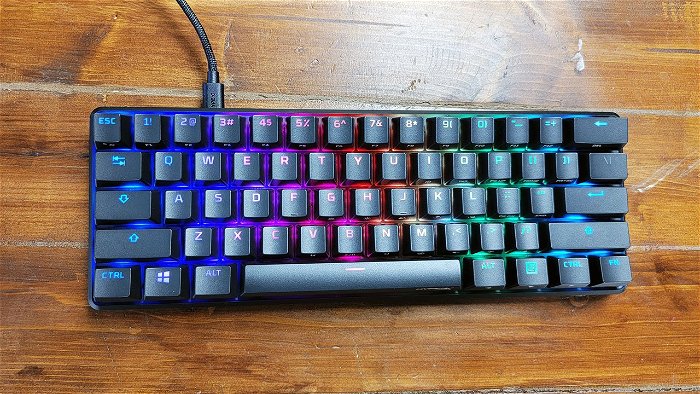
Another impressive aspect of this mini keyboard immediately becomes apparent the second you pick it up: The weight. Sporting a full aircraft-grade aluminum body, the Alloy Origins 60 exhibits superb build quality. Contrary to its petite profile, it feels weighty and expensive, just as a solid, high-end piece of gaming equipment should feel. Combined with the stability of four non-slip rubber feet on its underside, the added heft of the keyboard makes it extremely difficult to move or shift by accident, resulting in a sturdy, PC gaming companion. The same holds true even when the keyboard isn’t laying flat; it remains stable in either of its raised positions, which can be adjusted by flipping down one of two alternative sets of feet on the rear underside.
Many of the Alloy Origins 60’s design features read like a laundry list that serious PC gamers have long come to expect from a mechanical gaming keyboard these days. Double shot PBT keycaps (Polybutylene Terephthalate keycaps where two layers of plastic are molded into each other) ensure that the transparent letters, numbers and symbols on the top of each key won’t wear, fade or erode with use (a rather important feature since the effect of the keyboard’s built-in RGB backlighting would be severely impacted if parts of letters, numbers and such were to peel off and become illegible). Given the keyboard’s tightly packed layout, an unavoidable compromise inherent to all mini-keyboards has been made here as well; several keys pull double-duty, requiring to be pressed in combination with the Function (FN) Key in the bottom right corner of the keypad in order to access their secondary functions. Becoming dependent on the FN Key to perform traditional actions like moving a cursor forward or backward with the arrow keys, access Task Manager by pressing four buttons (CTRL + ALT + FN + DELETE) instead of the usual three or perform an “insert-style” deletion takes a little getting used to with this keyboard, but I can see it becoming second nature with enough practice. The alternative function of each key is printed on the front side for easy visibility and quick recognition.
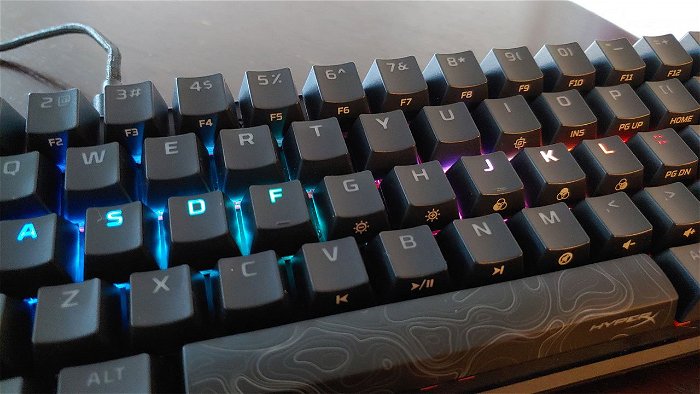
Going deeper, a durable, HyperX-brand mechanical switch rests underneath each one of the keypad’s 61 keys, which according to HyperX’s website are built to withstand over 80 million keypresses. Like the exposed engine on a classic muscle car, these switches are in open view and can even be replaced (or assumingly mixed and/or matched) with alternative colorways should the user want to personalize their keypad further. The Alloy Origins 60 provided for this review came with the standard red switches, and also includes a keycap puller and optional alternative-style ESC and SPACE keys to give the keypad a more HyperX-branded look. Speaking of branded, the keyboard supports USB-C and comes bundled with a braided, HyperX-logoed USB-C cable which is fully detachable and easily recognizable when placed against other standard cables, making it easier to follow the trail back to where the keyboard is connected if you are dealing with an unsightly jumble of wires behind your setup.
The real difference-maker however is HyperX’s NGENUITY software app, which not only powers the Alloy’s robust RGB lighting options and special effects but also allows the user to create custom profiles, key bindings, macros and other settings within the keyboard’s onboard memory, many aspects of which are retained across devices, be it PC, Xbox or PlayStation consoles. As someone who rocks a very unassuming gamer space and doesn’t usually go in for flashy peripherals or colourways, I especially found the RGB settings feature to be rather novel. Right off the bat you have a variety of nine special effects that can be applied to really make the keypad stand out, like “Breathing”, which pulsates a single color along the entire panel repeatedly, “Explosion”, which outwardly emanates a sudden burst of colour from a key when it is pressed, or “Wave”, which rotates a rainbow of colours across the whole keypad. A full spectrum of colours can be displayed within each effect, or users can select specific colours should they wish. They can also adjust the speed of the effect, such as how quickly or slowly the effect rolls across the keypad, the angle at which the effect occurs, as well as the brightness and the opacity of the effect.

Of course, these effects aren’t just limited to the larger keypad in general; they can even be applied to individual keys. Personally, I’m notorious for resting my fingers on the wrong keys in the home row, so I elected to personalize my keypad by illuminating the main eight home row keys with a rainbow wave effect while keeping all the other keys blacked out, but then combined it with the “Explosion” effect to add a ripple effect of purple with each keystroke. Understated, yet flashy all at once! Of course, it goes without saying that the Alloy Origins 60 will blend right in with the typically luminous décor of your average YouTuber, Twitch Streamer or Content Creator.
Individual keys (at both the base function layer as well as the FN key layer) can also be re-assigned to a variety of functions. The most obvious are the aforementioned macros and basic key bindings, but in addition the NGENUITY software makes it possible to assign any key to mouse functions, multimedia functions, or Windows shortcuts (e.g., opening Task Manager). Any key can also be completely disabled, and a “Game Mode” can be toggled on as well to automatically disable a handful of common key combinations that can accidentally take the user out of the game they are playing and back to the Windows desktop, or cause another type of game-breaking interruption. Finally, multiple keyboard presets and three individual profiles can be created and saved so that users can easily switch between them depending on the game they are playing.
I tested out the Alloy Origins 60 with a trio of games that I was at least somewhat comfortable playing with a keyboard and mouse setup, namely Portal 2 and The Witcher: Enhanced Edition on PC, and Call of Duty: Warzone on Xbox Series X, and I came away generally impressed. The keyboard was fast and responsive, and the only real downside I noticed was that I lacked a proper, equally customisable gaming mouse to pair it with. I was also delighted to see that the RGB lighting customization that I had saved to the keyboard while using it on PC remained the same when using it with my console.
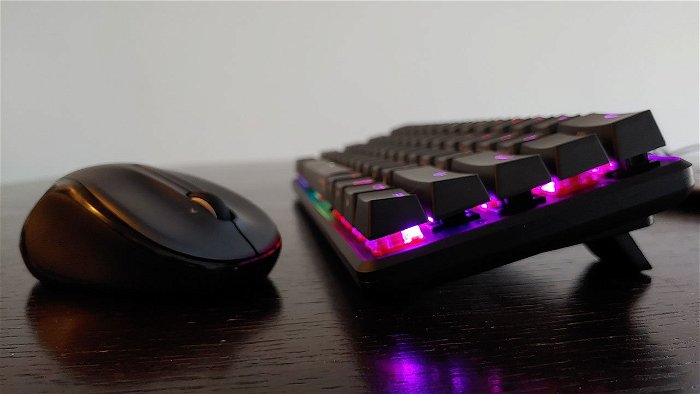
If there is one valid criticism that I can level against the Alloy Origins 60 is that while it’s all but perfect for twitch games like first-person-shooters, the travel time on the keys is a bit too sensitive for my liking when relying on them for more basic purposes, like writing this review for example. My fingers naturally tend to rest a bit heavy on the home row and are accustomed to standard keyboards that require more force to register a keypress. Meanwhile, over on the Alloy even if my fingers are completely at rest they will often sink into the keypad and trigger long lines of repeat letters like “s” and “k”. Sadly, there does not appear to be any way to adjust the keypad sensitivity via software; one must take it or leave it. As someone more familiar with full-size, non-mechanical consumer keyboards there are a few other issues I have with the Alloy, such as the extremely tight spacing, the lack of a full number pad and the previously mentioned reliance on the FN key to execute basic commands (which of course can be overcome with custom macros if that’s your thing), but such is the nature of the beast with mini-gaming keyboards and is by no means unique to HyperX’s product.
It’s for this reason that I feel that the HyperX Alloy Origins 60 is best regarded as a “specialist” device, rather than a general all-rounder, not unlike the high-end professional joysticks that fighting game enthusiasts break out when it’s championship time. The multiple compromises made in the pursuit of compactness are only a hindrance if the Alloy is being used as the main keyboard, and it’s quite clear that the Alloy Origins 60 wasn’t really designed with that function in mind. Players looking for a full-sized, full-featured keyboard prioritized for gamers can find what they are looking for among other alternatives in the HyperX Alloy line, or from direct competitors such as Razer.
In my humble opinion, the ideal place for a device like the Alloy Origins 60 is tucked away just within reach of one’s standard keyboard and ready to be swapped in like trusted sidearm in a competitive shooter. The Alloy’s compactness totally makes this possible, and if matched with an equally gaming-focused mouse, the Alloy Origins 60 is sure to be a competitive force to be reckoned with.
